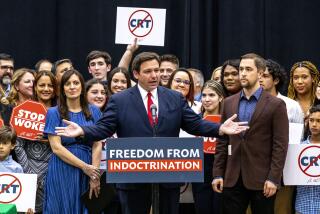HP’s ex-chief executive comes to her own defense
- Share via
After nearly two years in exile from news pages, Carly Fiorina is back, with impeccable timing.
The board that fired her as chief executive of Silicon Valley technology icon Hewlett-Packard Co. now looks like a collection of misfits for letting a Keystone Kops spy scandal get so out of hand that its former chairwoman, Patricia C. Dunn, faces criminal charges.
There’s talk of Fiorina someday running for political office. She’s serving on charity and corporate boards, including one company in cyber security. And she has a 319-page catharsis to sell, “Tough Choices,” which last weekend jumped onto the New York Times nonfiction list at No. 8 after Fiorina appeared on “60 Minutes.”
On Monday, her book tour brought her to Los Angeles, including a visit to The Times and a taping on the “The Tavis Smiley Show.” What’s clear is that the tough choice Fiorina now faces is figuring out how to move past what happened in her final weeks at HP.
Fiorina remains preoccupied with the board that she had answered to -- notably former members George A. Keyworth II and Thomas J. Perkins, who she said directors identified early on as a source of leaks to the media. Board leaks were what ultimately led to the ill-fated investigation that spun out of control after Fiorina left.
Fiorina repeatedly calls that board a “dysfunctional” group, and writes that its members were often amateurish, immature and cared only about what interested them.
“The fact that there was dysfunction, which intensified after I left, wasn’t surprising to me,” she said in an interview. “The extent to which that dysfunction intensified, and how it manifested itself
To backtrack, Fiorina was a law school dropout who became the nation’s highest-ranking woman in business when she was recruited from Lucent Technologies Inc. in 1999 to run HP. She already had been proclaimed in the business press as one of the nation’s most-powerful female executives.
But a woman leading a blue-chip company such as HP was another level altogether. It made her an instant celebrity, like it or not, and she says she didn’t.
Nonetheless, she went along with some of the trappings if, she concluded, it helped the company. She appeared at an event with Gwen Stefani that Fiorina says was to promote a camera the No Doubt singer designed for HP to help transform its stodgy image. She was pegged as star struck and relishing the attention even though she claims to have turned down scores of self-promoting opportunities, an appearance on “Oprah” and a Vogue spread among them.
Along the way, she laid off 36,000 people to slim the bloated company, and pulled off the acquisition of personal computer giant Compaq Computer Corp., a transforming event that was a preoccupation during much of her 5 1/2 years at HP.
In early 2005, she was fired. Fiorina says she was blindsided and still can’t fully explain it, owing it to the petty personal agendas of board members. Detractors argue that she failed to meet earnings targets, and that HP’s stock languished. Since earnings and stock price are the ultimate scorecard for any executive, how could she have been surprised?
Counters Fiorina: “If missed earnings and the stock being where it was are reason to be fired, there would have been a lot of other CEOs in Silicon Valley fired.”
In the end, she says, the explanation she got was: HP’s board “has decided to make a change at the top.”
“In the final two weeks of my tenure, I wasn’t involved in the decision-making process,” she said. “They made a very momentous decision in a very short period of time.”
Fiorina also appears to be plagued with a legacy that is inconclusive, which has turned her book tour into a chance for her to prove that her ouster was unnecessary. One problem she’s running into is that her replacement, Mark Hurd, has overseen a spectacular comeback that includes HP’s routing of industry PC leader Dell Computer.
Fiorina makes the case that HP was on its way toward recovery when she was dumped. She argues that customer satisfaction was rising, the company was churning out new patents at a rate of 11 a day and had turned a $900-million annual loss into a $3.5-billion profit within three years. Hurd, she implied, was reaping the fruits of her labor.
Nonetheless, she inexplicably seems to go out of her way not to mention Hurd’s name in her memoir, referring to him as “a new CEO” and “the new CEO.” Although she mentions his name in an interview, she said she didn’t mention him in the book “because he wasn’t part of my experience. The book was about my experience.”
She’s also still bothered that most board members didn’t have the guts to fire her face to face, that she was never thanked for her service and that she was asked to publicly lie by claiming that leaving was her idea.
Asked about the spy scandal, in which phone records were accessed and private detectives actually considered having people pose as janitors in newspaper offices, Fiorina offers a carefully crafted answer: She knew the board was a problem, but never dreamed it was so bad.
HP’s embarrassing sideshow lately probably proves her right. But it’s also clear from Fiorina’s book, and in talking to her, that she didn’t read her directors very well and had blinders on too long. She also seemed to put way too much faith in management systems and processes to fix the board dysfunction, as if kumbaya was just one PowerPoint presentation away.
She believed HP’s board could repair itself, needed operational CEOs in lieu of technology people and praised “360-degree feedback,” a management technique that would have had directors hold a mirror to themselves.
But would it have helped? In describing her childhood, middle child Fiorina says that she was the diplomat of her family, intervening in arguments, listening to both sides, and trying to strike compromises. Likewise, she still believes she could have done the same thing with her board, if only they had the resolve for self-examination. And it might have saved her job.
“People thought that’s not a good use of time -- it’s beneath us,” she said. “We should be talking about technology, not board dynamics. It’s what should have happened and it still hasn’t happened, apparently.”
More to Read
Sign up for our Book Club newsletter
Get the latest news, events and more from the Los Angeles Times Book Club, and help us get L.A. reading and talking.
You may occasionally receive promotional content from the Los Angeles Times.










